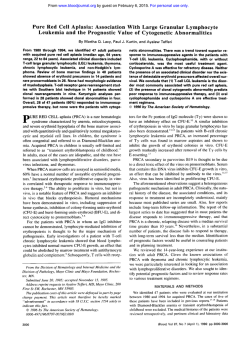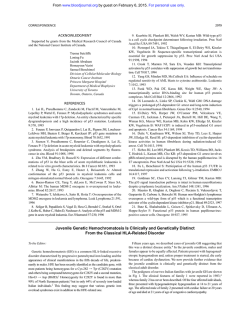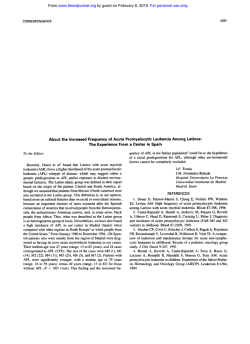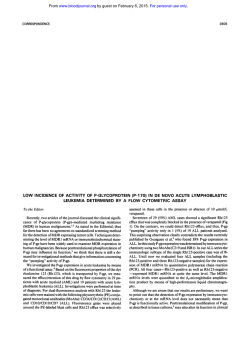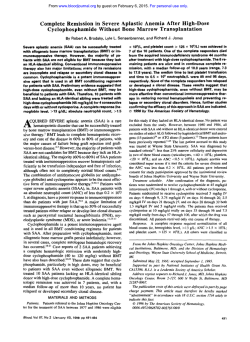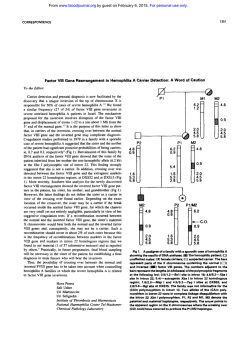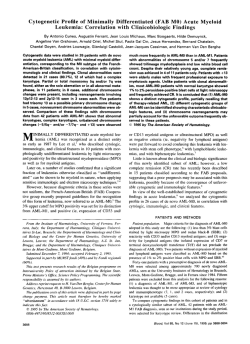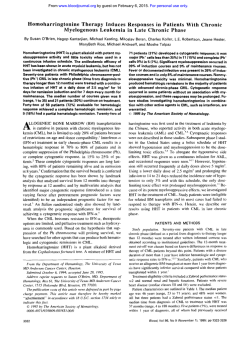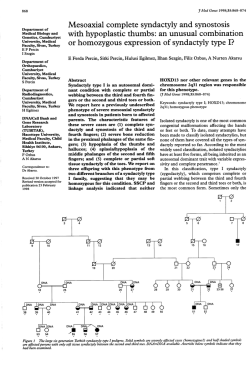
Pure Red Cell Aplasia: Its Clinical Association and
From www.bloodjournal.org by guest on February 6, 2015. For personal use only. CORRESPONDENCE 3244 Pure Red Cell Aplasia: Its Clinical Association and Treatment To the Editor: Lacy et all recently reported a series of 47 patients with pure red cell aplasia (PRCA). The characteristics of their patients included a high frequency (9/47 [19%]) of T-large granular lymphocyte leukemia (T-LGLL), the occurrence of clonal karyotypic aberrations in a proportion of cases (4/47 [SS%]), and a good response to cyclophosphamide (13/25 [52%]). Although their report provides a number of interesting findings on PRCA, there are still some unresolved issues. TThe highfrequency of T-LGLL in theirseriesisintriguing. LGLL is a relatively rare lymphoproliferative disorder in the West. Furthermore,whereastheassociationbetweenPRCAandB-cell chronic lymphocytic leukemia is better defined, PRCA has been infrequentlyobserved in T-LGLL,withonlysporadic cases beingdescribed.* On the other hand, the close association between T-LGLL andPRCAhasbeenwelldescribedinboththeJapaneseand Chinese.”Oshimi et a14 reported PRCA in 65% of their cases of TLGLL,whereaswefound a frequency of12.5% in a series of 16 Chinese patients with PRCA.’ Therefore, the ethnic origin of the patients is an importantconsiderationindeterminingtherelationship between PRCA and T-LGLL, because different clinicopathologic and epidemiologic factorsmay be involved. It would therefore be important to know the ethnic origin of the patients in the series of Lacy et al.’ Inthe series ofLacy et al,’ four patients were shown to have cytogenetic abnormalities. The presence of clonal cytogenetic abnormalities predicted a poor response to treatment, leading to the postulation that these cases might in fact represent a form of myelodysplasia. The currently used diagnostic criteria for PRCA do not distinguish between erythroid aplasia secondary to other systemic diseases or as a result of an intrinsic clonal disorder of erythropoiesis, although it is contentious if the latter should actually be classified as PRCA. It is therefore important to separate these two categories of PRCA, because immunosuppression will not only be ineffective in clonal myelopoietic disorders but also may even accelerate transformation. It would be important for Lacy et all to provide adequate follow-up data on these cases. Lacy et al’ suggested that cyclophosphamide and cyclosporin were among the most effective therapeutic agents for PRCA. However, it is noteworthy that no follow-up information was given for some of their cases in terms of the needand duration of maintenance treatment, whether the patients could be taken off therapy, and the relapse rate of these patients on and off treatment. Because PRCA From www.bloodjournal.org by guest on February 6, 2015. For personal use only. 3245 CORRESPONDENCE is a disease marked by relapses, the absence of this information makes it difficult to judge the appropriate choice of treatment. Furthermore, no discussion on the relative merits of treatment with cyclophosphamide and cyclosporin has been made in their report. The use of cyclophosphamide, which is an alkylating agent, an immunosuppressant, and a known bladder carcinogen, is significantly related to the subsequent development of malignancies, particularly This increased risk had been shown to those of urothelial persist up to 17 years after cessation of treatment. Cyclosporin has also been shown to increase the incidence of secondary malignancies.* This is thought to be related to the immunosuppressive effect rather than an intrinsic mutagenic property of the drug.' The safety of both forms of treatment will need to becompared, but physicians should be aware of these complications. Finally, whether the concomitant presence of T-LGLL predicted a good response of PRCA to treatment might be related to how well the leukemia was controlled. It is important to know whether the patients with T-LGLLassociated PRCA had received concomitant antileukemic therapy. Recently, we have seen two patients with T-LGLL complicated by PRCA (unpublished observation). Treatment with antithymocyte globulin resulted in adequate control of the T-LGLL and, hence, remission of the PRCA in one patient, whereas the other patient was refractory to all types of treatment for the T-LGLL and remained transfusion-dependent from the PRCA. K.F. Wong Depament of Pathology Queen Elizabeth Hospital Hong Kong Y.L. Kwong Department of Medicine Queen Mary Hospital Hong Kong REFERENCES 1. Lacy MQ, Kurtin PJ, Tefferi A: Pure red cell aplasia: Associa- tion with large granular lymphocyte leukemia andthe prognostic value of cytogenetic abnormalities. Blood 87:3000, 1996 2. Loughran TP Jr: Clonal diseases of large granular lymphocytes. Blood 82:1, 1993 3. Kwong YL, Wong KF, Chan LC, Liang RHS, Chan JKC, Lin CK, Chan TK: Large granular lymphocyte leukemia-A study of nine cases in a Chinese population. Am J Clin Pathol 103:76, 1995 4. Oshimi K, Yamada 0, Kaneko T, Hishinarita S, Iizuka Y, Urabe A, Inamori T, Asano S, Takahashi S, Hattori M, Naohara T, Ohira Y, Togawa A, Masuda Y, Okubo Y, Furusawa S, Sakamoto S, Omine M, Mori M, Tatsumi E, Mizoguchi H: Laboratory findings and clinical courses of 33 patients with granular lymphocyte-proliferative disorders. Leukemia 7:782, 1993 5. Kwong YL, Wong KF, Liang RHS, Chu YC, Chan LC, Chan TK: Pure red cell aplasia: Clinicopathologic features and treatment results of 16 cases. Ann Hematol 72:137, 1996 6. Radis CD, Kahl LE, Baker GL, Wasko MC, Cash JM, Gallatin A, Stolzer BL, Aganval AK, Medsger TA Jr, Kwoh CK: Effects of cyclophosphamide on the development of malignancies and on long term survival of patients with rheumatoid arthritis. A 20-year follow up study. Arthritis Rheumatol 38:1120, 1995 7. Travis LB, Curtis RE, Glimelius B, Holowaty ET, Van Ieeuwen FE, Lynch CF. Hagenbeek A, Stovall M, Banks PM, Adami J: Bladder and kidney cancer following cyclophosphamide therapy for non-Hodgkin's lymphoma. J Natl Cancer Inst 87:524, 1995 8. Gaya SB, Rees AJ, Lechler RI, Williams G, Mason PD: Malignant diseases in patients with long-term renal transplants. Transplantation 59:1705, 1995 9. Ryffel B, Mihatsch MJ, Fisher GL: Immunosuppression and cancer: The cyclosporin case. Drug Chem Toxicol 15:95, 1992 Response: Pure Red Blood Cell Aplasia: AssociationWith Large Granular Lymphocyte Leukemia andthe Prognostic Value of Cytogenetic Abnormalities We appreciate the letter by Wong and Kwong regardingour recent report on PRCA.' We reported on a series of 47 patients with PRCA and more than 90% of these patients were white. It should be noted that T-cell receptor gene rearrangement studies were performed in only 14 of the 47 patients and that the reported overall frequency of 19% maybe an underestimation. In two previous reports, we described 68 patients with T-cell LGL disorder and 10 patients with chronic natural killer cell lymphocytosis identified at our Institution over a IO-year The overall incidence of these disorders is increasing at both our institution and other centers because of increased awareness. Therefore, LGL disorders may not be as rare as suggested. We agree that the current diagnostic criteria do not distinguish clonal PRCA as a separate entity. Additional studies are necessary to confirm our observation regarding patients with PRCA and detectable clonal cytogenetic abnormalities. As stated in our previous report, none of the four patients with PRCA and cytogenetic abnormalities responded to immunosuppressive therapy including prednisone, oral cyclophosphamide, antithymocyte globulin, and cyclosporine A.' One of these patients developed pathologically evident refractory anemia with excess blasts after a follow-up period of 18 months. This was manifest by peripheral blood leukopenia and 3%circulating blasts. The bone marrow showed substantial dysmegakaryopoiesis and excess blasts. The second patient died of bacterial pneumonia at 19 months from the diagnosis of PRCA. The third patient is now 3 years from diagnosis and still requires blood transfusions. We were unable to obtain a follow-up on the fourth patient, who was from another country. All of the patients treated with cyclophosphamide or cyclosporine had prompt responses in 1 to 3 months. In the majority of these cases, the drugs were tapered and an effort was made to discontinue treatment after 3 to 6 months of therapy. In general, patients who were tapered offthe cyclosporine relapsed in 1 to 2 months and required ongoing maintenance therapy. However, unmaintained remissions were noted in some patients treated with cyclophosphamide, but late relapses have been frequent. We agree with Wong and Kwong that long-term complications from cyclophosphamide and cyclosporine should be discussed with the patients and, as is true with every situation, the risks and benefits have to be weighed in deciding particular forms of therapy. Currently, our treatment of PRCA is similar to our treatment of symptomatic patients with T-LGL leukemia? Therefore, none of our patients received additional antileukemic therapy other than corticosteroids and/or oral cyclophosphamide. Ayalew Tefferi Martha Q. Lacy Paul J. Kurtin Mayo Clinic/Foundation Rochester, M N REFERENCES 1. Lacy M, Kurtin PJ, Tefferi A: Pure red cell aplasia: Association with large granular lymphocytic leukemia and the prognostic role of cytogenetic abnormalities. Blood 87:3000, 1996 From www.bloodjournal.org by guest on February 6, 2015. For personal use only. 3246 2. Dhodapkar MV, Li CY, Lust JA, Tefferi A, Phyliky R L Clinicalspectrum of CD3(+) clonallargegranularlymphocyte (LGL) proliferations. Blood 84:1620, 1994 CORRESPONDENCE 3. Tefferi A, Li CY, Witzig TE, Dhodapkar MV, Okuno SH, Phyliky F&: Chronic natural killer cell lymphocytosis: A descriptive clinical study. Blood 84:2721, 1994 From www.bloodjournal.org by guest on February 6, 2015. For personal use only. 1996 88: 3245-3246 Response: pure red blood cell aplasia: association with large granular lymphocyte leukemia and the prognostic value of cytogenetic abnormalities [letter] A Tefferi, MQ Lacy and PJ Kurtin Updated information and services can be found at: http://www.bloodjournal.org/content/88/8/3245.citation.full.html Articles on similar topics can be found in the following Blood collections Information about reproducing this article in parts or in its entirety may be found online at: http://www.bloodjournal.org/site/misc/rights.xhtml#repub_requests Information about ordering reprints may be found online at: http://www.bloodjournal.org/site/misc/rights.xhtml#reprints Information about subscriptions and ASH membership may be found online at: http://www.bloodjournal.org/site/subscriptions/index.xhtml Blood (print ISSN 0006-4971, online ISSN 1528-0020), is published weekly by the American Society of Hematology, 2021 L St, NW, Suite 900, Washington DC 20036. Copyright 2011 by The American Society of Hematology; all rights reserved.
© Copyright 2024
